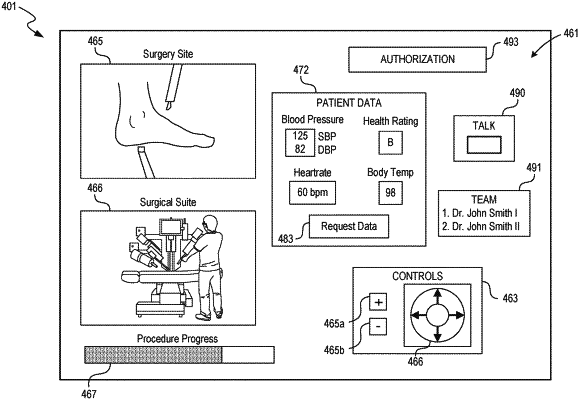| CPC A61B 34/10 (2016.02) [A61B 34/30 (2016.02); A61B 2034/102 (2016.02); A61B 2034/105 (2016.02)] | 22 Claims |

|
1. A computer-implemented method for performing surgery using a robotic surgical system, the method comprising:
obtaining pre-operative image data of a patient;
identifying at least one of a pre-operatively damaged ligament or a pre-operatively damaged tendon associated with instability of a joint of the patient based on the pre-operative image data;
generating a pre-operative three-dimensional virtual model representing anatomy in the pre-operative image data, wherein the pre-operative three-dimensional virtual model includes the at least one of the pre-operatively damaged ligament or the pre-operatively damaged tendon;
receiving a selection of a surgical procedure from at least one user; and
controlling a surgical robot to robotically perform at least a portion of the selected surgical procedure according to a surgical plan that is dynamically modified intraoperatively based on intraoperative patient data by:
receiving surgical repairing input from the at least one user, wherein the surgical repairing input includes a selected tool and a plurality of surgical repairing steps for repairing the at least one of the pre-operatively damaged ligament or the pre-operatively damaged tendon,
after the surgical robot performs at least one of the plurality of surgical repairing steps on the patient, intraoperatively generating a post-operative three-dimensional virtual model representing a repaired joint by virtually performing the plurality of surgical repairing steps, which have not been performed on the patient, on a real-time three-dimensional virtual model using:
capabilities of the surgical robot, and
the selected tool,
wherein the real-time three-dimensional virtual model represents anatomy in intraoperative image data obtained after the surgical robot performs the at least one of the plurality of surgical repairing steps on the patient, and
intraoperatively simulating post-operative dynamic behavior of the repaired joint using the post-operative three-dimensional virtual model,
displaying, via a user device, the simulated post-operative dynamic behavior of the repaired joint for the at least one user to evaluate joint functionality of the repaired joint,
receiving at least one joint functionality parameter from the at least one user,
determining, based on the at least one joint functionality parameter, a bone-to-ligament parameter to increase stability of the repaired joint in the post-operative three-dimensional virtual model to maintain a threshold joint functionality for the repaired joint, and
intraoperatively modifying the surgical plan, executable by the robotic surgical system, based on the intraoperatively simulated post-operative dynamic behavior of the repaired joint and the bone-to-ligament parameter to robotically perform, using the surgical robot, surgical repairing on the patient according to the received surgical repairing input.
|